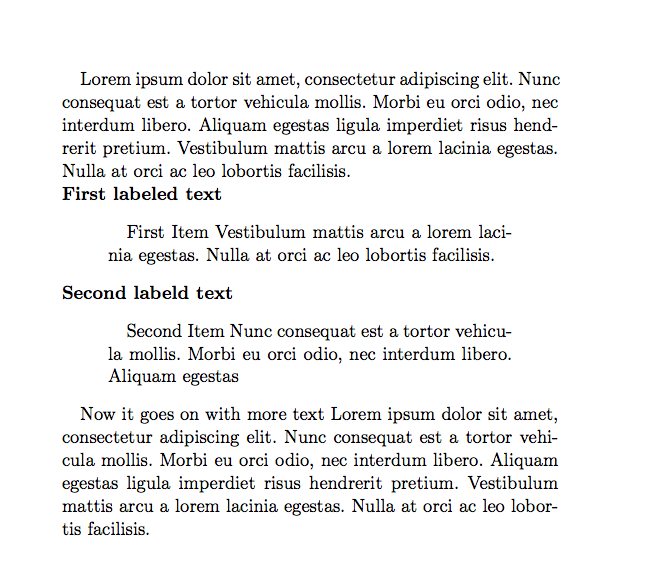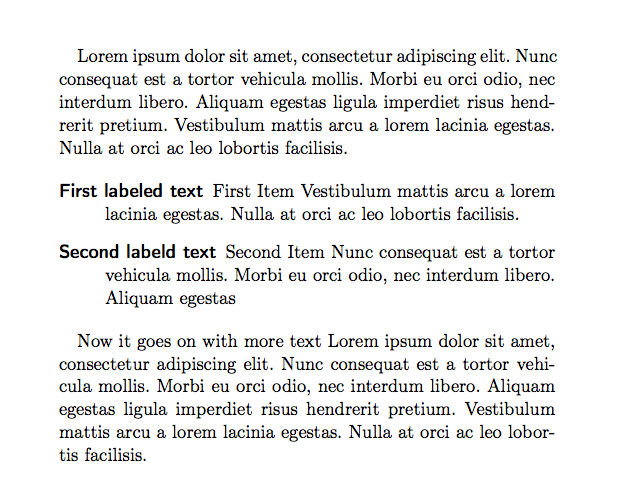Hey there!
Supports MMD the “description”-environment of latex? I like this kind of list so much.
Thanks
Hey there!
Supports MMD the “description”-environment of latex? I like this kind of list so much.
Thanks
Yes, there is indeed support for that. It was used extensively, with the formatting slightly altered, in the documentation PDF. To create a description list:
[code]Place the headline here
: And immediately follow that line (no blank link) with a colon-. To create a second definition list item, simple add a new paragraph after this one with another colon- prefix…
: Like so. These also follow the same rules as lists, in terms of multi-paragraph definitions. To create a second paragraph that is semantically a part of this definition, just add a full block space and tab:
This is now a part of the same second definition above, but will be typeset as a new paragraph. In LaTeX, there is little visual difference between a new definition item and a new paragraph within an item, but this distinction can be used within the XSLT for greater granularity if needed.
: * You can also create lists within the environment like this
* Just use the regular list syntax
Here is a new headline
: And a new term.
[/code]
Many thanks for the rapidly answer!
But i’m sorry, it does’nt work. If i try it this way:
Lorem ipsum dolor sit amet, consectetur adipiscing elit. Nunc consequat est a tortor vehicula mollis. Morbi eu orci odio, nec interdum libero. Aliquam egestas ligula imperdiet risus hendrerit pretium. Vestibulum mattis arcu a lorem lacinia egestas. Nulla at orci ac leo lobortis facilisis.
First labeled text
: First Item Vestibulum mattis arcu a lorem lacinia egestas. Nulla at orci ac leo lobortis facilisis.
Second labeld text
: Second Item Nunc consequat est a tortor vehicula mollis. Morbi eu orci odio, nec interdum libero. Aliquam egestas
Now it goes on with more text Lorem ipsum dolor sit amet, consectetur adipiscing elit. Nunc consequat est a tortor vehicula mollis. Morbi eu orci odio, nec interdum libero. Aliquam egestas ligula imperdiet risus hendrerit pretium. Vestibulum mattis arcu a lorem lacinia egestas. Nulla at orci ac leo lobortis facilisis. it generates this output:

But i want it like this:

The text above produces not a “description”-environment, but this kind of tex-code (only the item-sequence):
[code]\noindent\textbf{First labeled text}
\begin{quotation}
First Item Vestibulum mattis arcu a lorem lacinia egestas. Nulla at orci ac leo lobortis facilisis.
\end{quotation}
\noindent\textbf{Second labeld text}
\begin{quotation}
Second Item Nunc consequat est a tortor vehicula mollis. Morbi eu orci odio, nec interdum libero. Aliquam egestas
\end{quotation}
[/code]
This looks very strange to me…
Greets
Are you using a custom XSLT or something? The result I get; the out of the box default, is:
\begin{description}
\item[First labeled text] First Item Vestibulum mattis arcu a lorem lacinia egestas. Nulla at orci ac leo lobortis facilisis.
\item[Second labeld text] Second Item Nunc consequat est a tortor vehicula mollis. Morbi eu orci odio, nec interdum libero. Aliquam egestas
\end{description}Hi Amber!
You made it!
But it is a little bit different. I used the following entry in the MMD-meta data, to get an empty pramble:
LaTeX XSLT
latex-snippet.xslt
But this was not the problem. I deleted it an used the build-in memoir-class: the same strange result. Then i deleted the MMD-package, I installed in dez 2009, to make the latex-snippet work. And this was the solution! Without this installation, everything works in the expected way. Yeah!!
Now there is one thing, I don’t understand: Why does the latex-snippet.xslt now work well, although the MMD-Installation ist deleted? Has Scrivener 2.0 more MMD-features then 1.5?
Greetings from Vienna
Yes, not only does 2.0 have more MMD features in the software itself, it also has a very recent MMD build inside of it—so if you were using an old custom installation, the package shipped with Scrivener is probably newer; it was taken fresh off of the development servers in November. Removing the custom install caused Scrivener to revert to the built-in copy.
Wonderful!
Thank you very much!